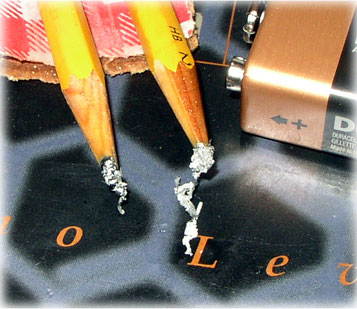 by Preston MacDougall December 02, 2005
At first, I thought that this was just an outward sign of method acting. Then, during a 2003 chemistry convention at Middlesex Community College, I got my first taste of a HooAH! bar. It's not what you might be thinking. Chemistry conventions are not at all like Tail-Hook Conventions. With a group of chemical educators, I took a side-trip to the U.S. Army Soldier Systems Center in Natick, Massachusetts, and learned that the HooAH! bar is a concoction of lipids, vitamins, dried fruit, flavoring, and, crucially, a blend of simple sugars and complex carbohydrates.
I was surprised by how much chemical research had been invested into this basic ration. But delivering food energy to the body, both rapidly, and over an extended period (you wouldn't want to have a "sugar slump" while on patrol in Baghdad), isn't a piece of cake. Additionally, the Army requires a storage life of at least three years at 80 degrees, or six months at 100 degrees, on the Fahrenheit scale. The HooAH! bar passed all these tests, and soldiers comment that they are quite palatable as well. HooAH! bars, however, are facing their toughest challenge this year - Wal-Mart shoppers. Watch out for falling prices! (As we saw on Black Friday, consumers can charge violently from stores with high prices to stores with low prices.) If real soldiers were like toy soldiers, they could just plug in fresh batteries when their energy levels get low. Students don't easily see the connection, but batteries and snack bars are both means of storing chemical energy. What we call "electricity" is just the movement of electrically charged particles that are already in the materials making up a Game Boy, for instance. The force that causes them to move is the difference between the potential energies of the chemical reactants stored at the opposite ends of a battery - a quantity that you might have guessed is measured in volts. The word volt comes from the inventor of the "electric pile", the forerunner of what we now call a dry-cell battery. Alessandro Volta was Professor of Natural Philosophy at the University of Pavia in Northern Italy. In 1799, he was shocked by the result of alternately stacked discs of the metals zinc and silver, separated by cardboard soaked in salt water. As they say, the rest is history. The American Chemical Society recently commemorated one particularly important moment in that history. The Energizer Bunny was on hand, and quite charged-up, when a vintage, six-inch, 1.5-volt Columbia dry-cell battery was given National Historic Landmark status in Cleveland, Ohio. The Bunny works for the Energizer Company, the descendent of the National Carbon Company, which, in 1896, produced the first battery for the mass market. National Carbon tweaked the voltaic pile by replacing the silver cathode with a graphitic carbon one - quite economically but not quite that simply. You see, I am leaving out some chemical details. For instance, it is actually silver oxide (a form of tarnish) that gave Volta his extra volts. How much fun do you think you can have with a 9-volt battery, a piece of cardboard, and two pencils? With an energized imagination, quite a lot! HooAH! Tape a fresh 9-volt battery to a piece of cardboard the size of a playing card. (Note that you don't soak your cardboard in salt water - it must be stiff.) Sharpen both ends of the pencils (#4 pencils work well, their "leads" are high in graphite, but a two will do). Tape them to the cardboard as well, ensuring that each is firmly in contact with one of the terminals (the nubby things that snap into your electronic devices). You have just constructed your very own electrolysis unit! You can use it to do all kinds of titillating electrochemistry. If you dip just one of the protruding pencil tips into a solution of fruit juices, detergents, or whatever you want to experiment with, not much will happen. It takes two to Tango, and it takes two electrodes to create a potential difference, or voltage. Depending on what you dip your unit into, you may notice quite different things happening at the ends of the pencils connected to the positive and negative terminals of the battery - called the cathode and anode, respectively. Even if both just appear to fizz, at the molecular level quite different chemistry is happening: oxidation at one, reduction at the other. If you dip your unit into a solution of tin salts, you can watch so-called "trees of Jupiter" grow. Resembling tiny, shiny trees, Alchemists gave these branching crystals of metallic tin the Latin name arbor Jovis. So-named because Alchemists used the same symbol for tin that astrologists used for Jupiter. If the action slows down, it may not be a dead battery, but a passivated electrode. No worries. By Jove, they can be re-activated with a pencil sharpener.
Publish A Letter on SitNews Read Letters/Opinions Submit A Letter to the Editor
|
||
